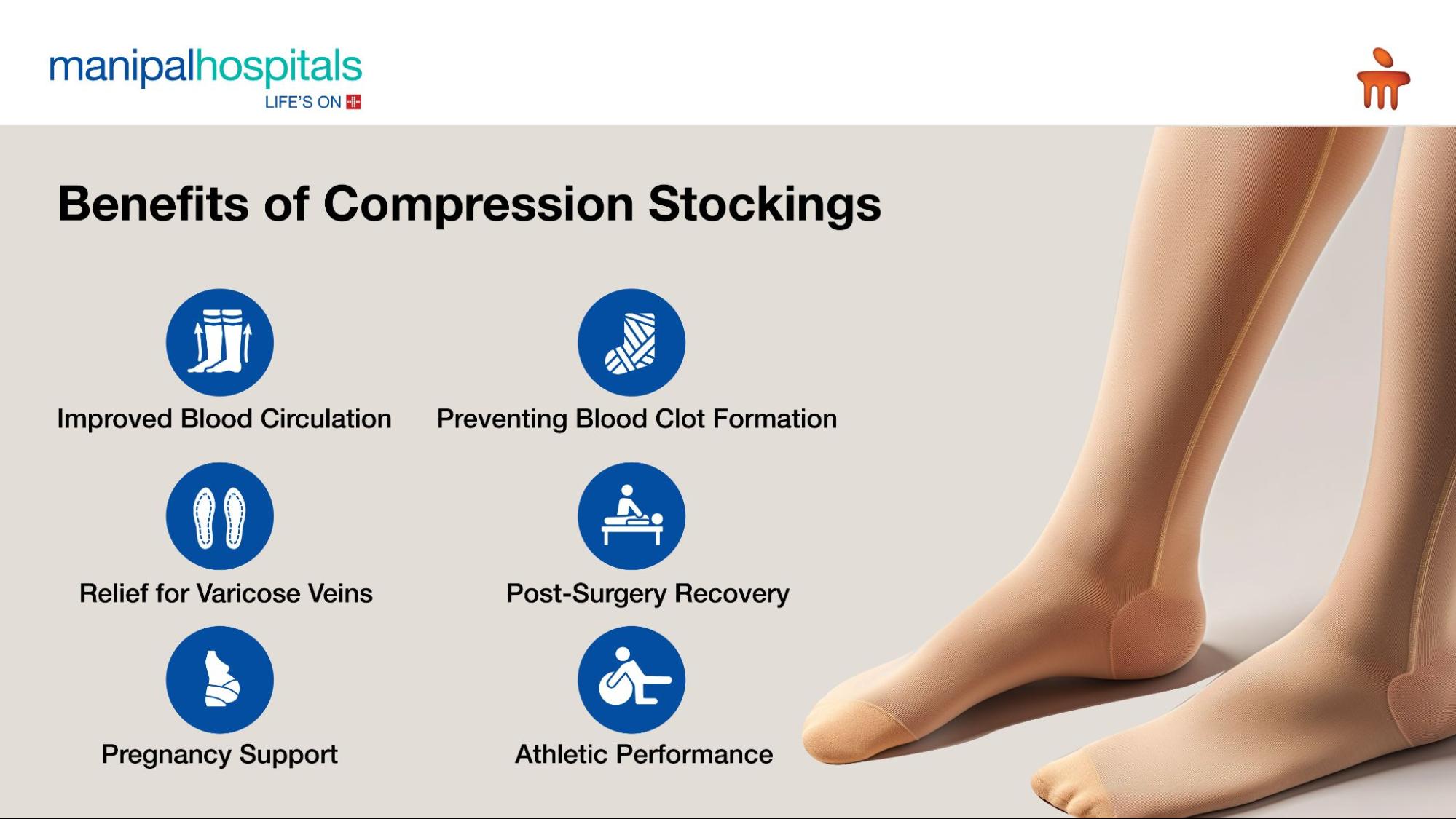
Whenever we sprain our feet or ankles, we often choose the handy crepe bandage to tie it around the affected area. The added compression helps heal the sprain. The levelled-up convenient form of tying the crepe bandage comes in the form of a compression stocking. Compression stockings are specially made to fit tighter and gently squeeze the swollen feet.
These stockings aim to improve blood flow to the legs, reducing pain and swelling and preventing blood clot formation. Moreover, compression stockings are also beneficial for individuals dealing with various circulatory and vein-related issues.
Synopsis
Understanding Compression Stockings
Compression stockings apply gentle pressure that pushes fluid up the leg and prevents swollen feet and fluid pooling in the lower limbs. The pushing up of the fluid allows the blood in the veins to flow freely from the legs to the heart. The compression helps to improve blood flow in the veins, reducing foot pain, swelling, blood clots, and other circulatory problems.
Compression stockings come in various pressure levels, as they should be snug but not painfully tight. The pressure exerted by compression stockings is measured in millimetres of mercury (mmHg), with different levels of compression recommended for various conditions. Mild compression stockings (8-15 mmHg) are often used for general leg fatigue and swelling. Higher compression levels (20-30 mmHg or more) are used for a firmer fit to avoid more severe conditions like varicose veins or deep vein thrombosis (DVT).
While most compression stockings go below the knee, thigh-high or waist-length stockings are also available. Based on the pressure exerted, compression stockings are of two types.
Graduated compression stockings tend to be tighter around the ankles and become looser as they go higher.
Anti-embolism stockings apply the same pressure throughout. These stockings, mostly used after surgery, help maintain blood circulation and reduce severe swelling.
Who Can Wear Compression Stockings?
While you don't necessarily need a prescription for compression stockings, doctors often recommend them for the following people
-
People who have varicose veins, deep vein thrombosis, or diabetes
-
Those recovering from surgery
-
Anyone at risk of oedema (swelling)
-
Bedridden individuals or those who cannot move about easily
-
Workers who sit or stand all day at their jobs
-
Athletes, especially those playing sports
-
Frequent flyers spend long amounts of time on planes
-
Pregnant women
-
Those who have foot pain due to a sprain or injury
Benefits of Compression Stockings
Compression stockings help maintain vein health and improve overall circulation. Here are the benefits of wearing them:

1. Improved Blood Circulation
These tighter stockings enhance blood flow in the veins by applying gentle pressure to the legs. They help to counteract gravity's effects and promote blood's return to the heart. This can alleviate leg heaviness, swelling, and fatigue, especially for those who spend long periods standing or sitting.
2. Preventing Blood Clot Formation
Another benefit of compression stockings is reducing the risk of blood clots, especially in deep vein thrombosis (DVT). By improving blood flow and preventing blood from pooling in the veins, these stockings can help prevent the formation of potentially dangerous clots.
3. Relief for Varicose Veins
Varicose veins are a common condition characterised by twisted, enlarged veins that often appear blue or purple. Compression stockings can lower the discomfort and swelling associated with varicose veins by promoting better blood flow and reducing the pressure on the affected veins.
4. Post-Surgery Recovery
Doctors recommend compression stockings for individuals recovering from surgery, particularly procedures involving the legs or abdomen. By promoting better circulation and preventing blood clots, these stockings aid healing and reduce complications.
5. Pregnancy Support
During pregnancy, the added weight and pressure on the veins can lead to swelling, leg cramps, and varicose veins. Wearing compression stockings relieves symptoms by improving circulation and reducing the strain on the veins.
6. Athletic Performance
Many athletes, particularly runners and cyclists, use compression stockings to enhance their performance and recovery. By improving blood flow and reducing muscle fatigue, these stockings can help athletes train harder and recover faster from intense workouts.
Things to Remember
To ensure the effectiveness of wearing compression stockings, there are certain things to keep in mind:
-
Wear the stockings in the morning before swelling or fatigue sets in.
-
Remove any jewellery or watches before wearing the stockings to avoid the material from tearing.
-
Use talcum powder to help slide the stockings on more easily.
-
Prevent wearing compression stockings while sleeping, as they can restrict circulation during extended periods of inactivity.
Conclusion
From athletes to office workers, from pregnant women to those recovering from surgery, from suffering minor sprains to feeling relief from heaviness in the limbs, compression stockings help promote vein health and improve overall circulation.
If you have consistent swelling in the legs, varicose veins or deep vein thrombosis, our experts from the Department of Orthopaedics are here for you. They will help identify the possible causes of your swollen feet and foot pain and create treatments tailored to you.
FAQ's
Compression stockings are often recommended for people with varicose veins, deep vein thrombosis, diabetes, leg swelling, or those at risk for blood clots. They can also help during pregnancy, after surgery, for athletes, frequent travellers, and those who sit or stand for long periods.
The graduated compression helps push the venous blood up the legs, preventing it from pooling and improving circulation back to the heart. This reduces swelling, fatigue, and blood clots or varicose veins.
Compression levels range from mild (8-15 mmHg) to firm (30-40 mmHg) or higher. Your doctor will recommend the appropriate level based on your condition and needs.
Apply talcum powder or a stocking aid to your legs first. Then, roll or gently pull the stocking up your leg, careful not to make it twist. Smoothing from the ankle up can help avoid wrinkles.
It's best to put them on first thing in the morning before swelling occurs. It can also be worn if you are standing, walking or sitting for long periods. Take them off before bedtime to allow for improved circulation while resting.
Most can be worn daily, but follow your doctor's advice. Replace worn or damaged stockings regularly to maintain proper compression levels.





















 6 Min Read
6 Min Read




















